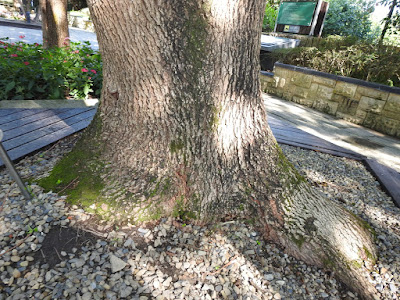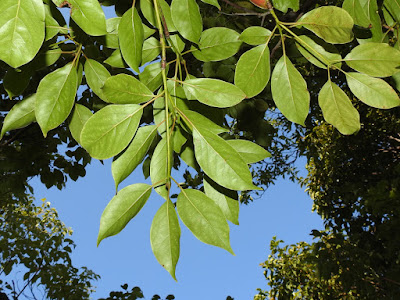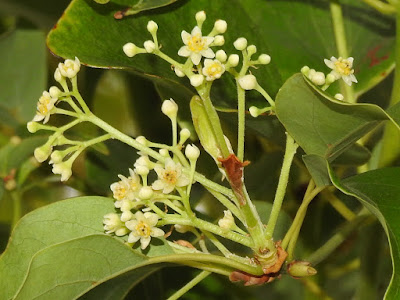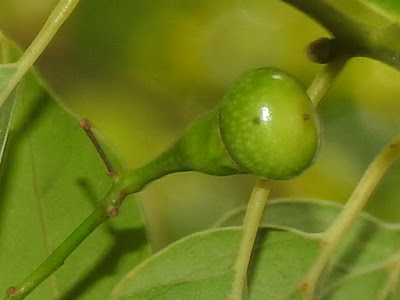In fact, the use of wood is only a trivial reason for the large-scale felling of Stout Camphor Tree. The main reason is because of a kind of fungus on Stout Camphor Tree. It only grows in the hollow of the rotten inner wall of the trunk or the dead and fallen trunk of Stout Camphor Tree due to the dark and damp surface. It is named "Antrodia cinnamomea" or "Taiwanofungus camphoratus", which is also endemic to Taiwan. It is not easy to find the aforementioned habitat, so the number is very rare. Antrodia cinnamomea contains triterpenoid compounds, which are believed to inhibit cancer cells. It is a very precious Chinese medicinal material. Taiwanese people call it "the ruby in the forest". In order to harvest Antrodia cinnamomea, the "mountain mouse" (Taiwanese call the wood thieves) did not hesitate to cut down the entire Stout Camphor Tree, and even cut the trunk into an appropriate size to facilitate taking it down the mountain. The cut-logs are used to grow Antrodia cinnamomea. Due to the huge benefits of Antrodia cinnamomea, the middle and low altitude Stout Camphor Trees have been almost completely cut down, and it has been listed as a first-class conservation tree species.
There is another reason why Stout Camphor Tree is endangered. The natural reproduction rate of its seeds is very low. Due to the tall tree shape of Stout Camphor Tree and the flowers and fruits growing on the upper layer of the tree canopy, most of the seeds have been eaten by birds and other animals before being mature. The fallen ones are also difficult to germinate because of the thick dead branches and leaves. Even if there is soil germination, it will be broken due to factors such as insufficient light, so it is not easy to see the seedlings of Stout Camphor Tree in the wild. Breeding mainly depends on the sprout tillers produced by the base sucker. In view of the increasing demand for Antrodia cinnamomea, the national treasure-level Stout Camphor Tree also needs to be actively protected. Some biotech operators have begun to restore Stout Camphor Tree, and the Forestry Bureau of the Agricultural Committee is also actively mentoring the operators. Rented land is used for afforestation, but it is not easy to propagate Stout Camphor Tree by seeds or cuttings. After years of hard work, technical difficulties have been overcome, and many places have been successfully afforestationed.
Stout Camphor Tree
(2021.4.4 Taiwan)
About Stout Camphor Tree
| ◆ | Classification: Genus Cinnamomum; Family Lauraceae | |
| ◆ | Scientific name: Cinnamomum kanehirae Hayata | |
| ◆ | English Name: Stout Camphor Tree | |
| ◆ | Chinese name: 牛樟、冇木、牛樟木、樟牛、沈水樟、水樟、臭樟、黃樟樹 | |
| ◆ | Origin: Endemic to Taiwan | |
| ◆ | Growth environment: Grows in jungles, valleys, or open areas in the flat to mid-altitude mountains of Taiwan, about 1700 meters above sea level. | |
| ◆ | Growth habit: Large evergreen tree | |
| ◆ | Height: Up to 30 meters, diameter at breast height up to 30 to 60 cm or more | |
| ◆ | Stem: The bark is dark brown, with rough surface, often with longitudinal cracks; small branches are yellow-green | |
| ◆ | Leaf | |
| 》 | Simple, alternate, leathery; ovate, elliptic, ovate-elliptic; base rounded or cuneate to broadly cuneate, apex pointed, often with short caudal point; entire margin | |
| 》 | Leaves about 8 to 11 cm long and 4 to 5.5 cm wide; petiole about 0.8 to 2.3 cm long, smooth and hairless; no stipules | |
| 》 | Terminal buds ovoid, about 0.6 cm long and 0.5 cm wide; bud scales are closely arranged in imbricate, broadly oval, apex obtuse or with small protuberances, and covered with brown silky pubescent hairs | |
| 》 | Upper surface green and shiny, lower surface lighter; both sides smooth and glabrous; young leaves red; fallen leaves red | |
| 》 | Lateral veins pinnate or inconspicuous three-outlet veins | |
| ◆ | Flower | |
| 》 | Bisexual flowers, panicles, terminal orr axillary | |
| 》 | Pedicel about 0.5 to 0.8 cm long; the diameter of the corolla when the flower opens is about 0.5 to 0.6 cm | |
| 》 | Tepals 6, white, connate tubular base at base, thickened fruit holder in fruit; 2 whorls, nearly equal, oblong, about 0.2 to 0.3 cm long, caducous, smooth outside, hairy inside | |
| 》 |
Stamens →Complete stamens 9, 3 whorls, anthers 4-loculed, valved →First and second rounds of filaments about 0.1 to 0.2 cm long, without glands, with villous bases, and anthers indoors. →3rd whorl of filaments glandular, tomentose at base, glands subsessile, anthers outward →3 staminodes, arrow-shaped, located in the innermost whorl |
|
| 》 | Pistil carpel 1, style 1, stigma capitate; ovary 1-loculed, superior, terminal placenta | |
| ◆ | Fruit: Drupe, oblate-conical or oblate-spherical, about 1 to 1.2 cm long, about 1.2 cm in diameter, with a pot-shaped fleshy receptacle about 0.9 cm long at the base; the drupe is purple-black when mature; 1 seed in the drupe | |
| ◆ | Flowering and fruiting period: Flowering in spring; fruiting in summer | |
Stout Camphor Tree is a plant endemic to Taiwan. It is distributed in the mountains at about 1,700 meters above sea level from flat to mid-altitude. It grows in jungles, valleys or open areas. It is currently listed as an "EN" (endangered) vascular plant.
Stout Camphor Tree
(2021.1.9 Taiwan)
It is a large evergreen tree.
Stout Camphor Tree
(2021.1.9 Taiwan)
It's plant height can reach 30 meters.
Stout Camphor Tree
(2021.6.13 Taiwan)
The diameter at breast height can reach 30 to 60 cm or more.
Trunk of Stout Camphor Tree
(2021.1.9 Taiwan)
The surface of it's trunk is rough, often with longitudinal cracks.
Trunk of Stout Camphor Tree
(2021.1.9 Taiwan)
Branchlets are yellow-green.
Sprigs of Stout Camphor Tree
(2021.1.9 Taiwan)
Leaves are simple, alternate.
Phyllotaxy of Stout Camphor Tree
(2021.1.9 Taiwan)
Leaf of Stout Camphor Tree
(2021.1.9 Taiwan)
The leaves are about 8 to 11 cm long and 4 to 5.5 cm wide; the petiole is about 0.8 to 2.3 cm long, smooth and hairless; no stipules.
Terminal buds are ovoid, about 0.6 cm long and about 0.5 cm wide. Bud scales are closely arranged imbricate, broadly oval, apex obtuse or with small protuberances, and are covered with brown silky pubescent hairs.
Young leaves are red.
Young leaves of Stout Camphor Tree
(2021.4.4 Taiwan)
Young leaves of Stout Camphor Tree
(2021.4.4 Taiwan)
Fallen leaves are red.
Fallen leaf of Stout Camphor Tree
(2021.1.9 Taiwan)
The lower surface of the leaf is lighter in color. Both surfaces are smooth and glabrous. The lateral veins are pinnate or inconspicuously three-veined.
Flowers are bisexual, panicles, terminal or axillary.
Flowers pedunculate, about 0.5 to 0.8 cm long.
Inflorescence of Stout Camphor Tree
(2021.4.4 Taiwan)
Flowers of Stout Camphor Tree
(2021.4.4 Taiwan)
Complete stamens 9, 3 whorls, anthers 4-loculed, valved. Staminodes 3, arrow-shaped, located in the innermost whorl.
Flowers of Stout Camphor Tree
(2021.4.4 Taiwan)
Pistil carpel 1, style 1, stigma capitate; ovary 1-loculed, superior, terminal placenta.
Flowers of Stout Camphor Tree
(2021.4.4 Taiwan)
It's fruit is a drupe.
Fruit of Stout Camphor Tree
(2021.5.1 Taiwan)
The drupe is oblate-conical or oblate-spherical, about 1 to 1.2 cm long and 1.2 cm in diameter, purple-black when mature. There is 1 seed in the drupe.
The base of the drupe has a pot-shaped fleshy receptacle about 0.9 cm long.
Fruit of Stout Camphor Tree
(2021.5.1 Taiwan)
^

























沒有留言:
張貼留言